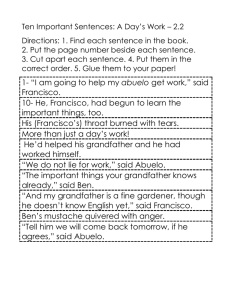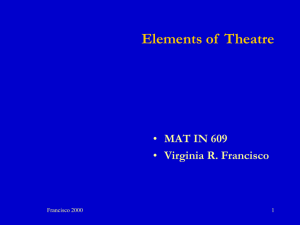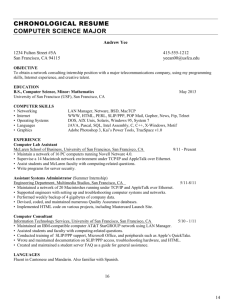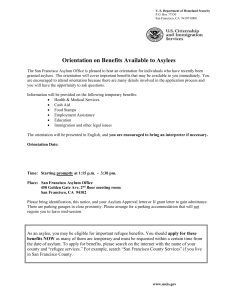The Circuit - Latin American & Iberian Institute
advertisement
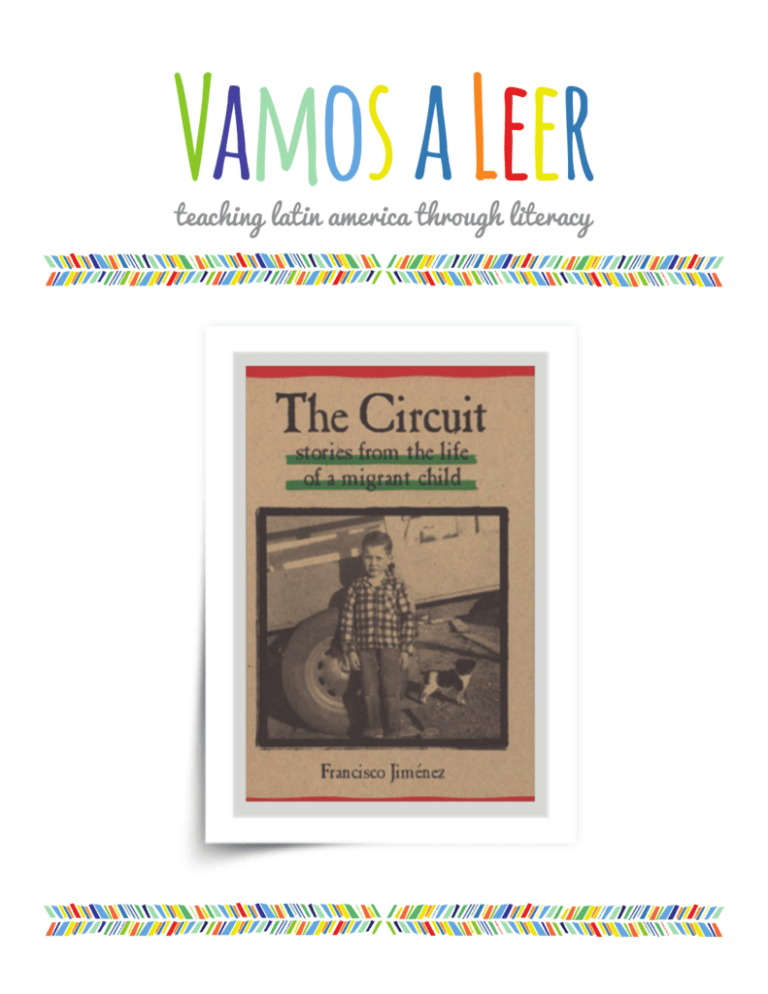
Vamos a Leer teaching latin america through literacy The Circuit Written by Francisco Jiménez Published by Houghton Mifflin, 1997 ISBN: 978-0826317971 Ages 10 and up VAMOS A LEER Educator’s Guide BOOK SUMMARY After dark in a Mexican border town, a father holds open a hole in a wire fence as his wife and two small boys crawl through. So begins life in the United States for many people every day. And so begins this collection of twelve autobiographical stories by Santa Clara University professor Francisco Jiménez, who at the age of four illegally crossed the border with his family in 1947. “The Circuit,” the story of young Panchito and his trumpet, is one of the most widely anthologized stories in Chicano literature. At long last, Jiménez offers more about the wise, sensitive little boy who has grown into a role model for subsequent generations of immigrants. These independent but intertwined stories follow the family through their circuit, from picking cotton and strawberries to topping carrots–and back again–over a number of years. As it moves from one labor camp to the next, the little family of four grows into ten. Impermanence and poverty define their lives. But with faith, hope, and back-breaking work, the family endures. (Taken from http://www.amazon.com/The-Circuit-Stories-MigrantChild/dp/0826317979/ref=tmm_pap_title_0). AWARDS & RECOGNITIONS The Américas Award 1997 • • • • Selected title for the 1997 Booklist Editors' Choice. Winner of the 1997 John and Patricia Beatty Award from the California Library Association Winner of the 1998 Boston Globe-Horn Book Award for Fiction. UNM Latin American & Iberian Institute | 2 AUTHOR’S CORNER A little bit about Francisco Jiménez’s writing in his own words: I worked on that first book, The Circuit, every single day. I started very early in the morning, right after breakfast. And I would sit at the computer and then it would take me awhile to capture the emotions I felt as a child. So I would sit there and contemplate. And once I was able to capture the emotions and the feelings of what I was reflecting on and remembering, then I would start to write. Then it would flow. Sometimes it was very painful, because I would actually get emotional as I was writing. Then I would take a break for lunch and then I would come back and start writing again. Sometimes, the emotions would be so strong that I would continue working till midnight. I would go to bed and I couldn’t sleep because all the things that I was thinking about and writing about kept coming to me. So, I decided then to keep a little notepad on my dresser, and when things would come to me, I would jot notes down and they would help me the following day to continue writing. So it was a catharsis in a sense. With The Circuit, I went through what I call the “five Rs” in writing the stories. The first “R” is Research. I interviewed my parents, my brother and some other family members. And then I looked through family documents and some family pictures that I used in the books. I also found some school records that were very helpful to me. And I visited the little towns and places where we had lived in migrant labor camps in the San Joaquin Valley in California, and that was very helpful. All these things brought a lot of the memories to me. And I listened to the music that I listened to as a child, and all the emotions came. I also visited museums to see if I could find information about that period in which we lived in those migrant labor camps. Unfortunately, there wasn’t any at all, nor in the archived newspapers. The second “R” is Recall. As I reviewed all the material, I began to recall things that I experienced as a child. And as I recalled some of those experiences, I began to remember other things, and one thing led to another. The third “R” is Reflect. And that’s probably one of the most important parts in the writing — to reflect on those experiences. I asked myself, “What did those experiences teach me as a child?” I asked myself what I learned from them as a child, not as an adult, because I wanted to maintain the child’s point of view. In the reflection, I made a series of discoveries of who I was and what my place was in our society. There was a sense of clarity about why I went through that life experience. And that clarity for me was that I was to write about it. And my discovery of self and my place in society, and my responsibility now as a teacher in trying to help other younger people to become educated was all very clear to me. And then the next “R” is “Write,” or to at least begin the process of writing. (I know it starts with a W, but I cheated.) I looked at all the different, meaningful experiences and decided which of those experiences were the most meaningful. Then I created a story around each one of those experiences. And then the fifth R is “Re-write.” For each story I wrote, I went through many, many drafts. (Adapted from an interview at http://www.teachingbooks.net/content/Jiménez_qu.pdf) UNM Latin American & Iberian Institute | 3 For more on Francisco Jiménez check out the links below: • His biography on Santa Clara University’s website • A student led interview of Jiménez • A biography of Jiménez from Scholastic Books • An interview with Jiménez from TeachingBooks USING THE CIRCUIT IN THE CLASSROOM “Not since Tomas Rivera’s . . . .and the earth did not part has a book expressed so well the experiences of the migrant campesinos as Francisco Jiménez has done in The Circuit. Its contents are representative of the best in the field of Chicano short story.” ---Luis Leal The Circuit is a series of independent but intertwined short stories that brings the reader into the life of a young Francisco Jiménez, or Panchito as he was known as a child. Each autobiographical chapter can stand on its own, but when read in its entirety, it tells the story of Jiménez’ childhood growing up in a family of migrant farm workers. While this may be a slightly different style of novel than many students are used to, it’s actually quite reader friendly. Jiménez’s writing style is simple and clear—but not simplistic. He manages to capture the tone of a young boy, engaging both young and old readers alike. He expresses the emotions of Panchito in a way that a child could understand and relate to, but that also deeply move the adult reader. Rudolfo Anaya describes The Circuit in the following manner: “This is truly a telling of the American Dream, a family who works hard under the worst of circumstances, and whose work is never recognized. . . .The family’s odyssey is heartrending, but it is the truth, and it’s skillfully told by someone who’s been there.” Too often our classroom discussions of the American Dream gloss over or ignore stories like that of the Jiménez family. At the beginning of the book, Jiménez writes, “. . .Papá’s eyes sparkled whenever he talked about it with Mamá and his friends. ‘Once we cross la frontera, we’ll make a good living in California,’ he would say, standing up straight and sticking out his chest” (p. 1). Unfortunately, our discussions of the possibilities of the American Dream, or even more recent conversations around immigration, stop there. They don’t consider the rest of the story—what it was actually like for the Jiménez family, moving constantly, living in tents or run down shacks, barely making enough money to survive. It’s easy to see why we might ignore this part of the story—it flies in the face of what we would like to believe is possible with hard work and commitment, it discredits our American Dream. Yet, if we want to present the truth to our students, we have to expose them to stories like that of Francisco Jiménez. Not only because it may teach them a part of our country’s history they’re not familiar with, but it may also legitimize a part of history that some of our students are all too familiar with because it represents their own family’s story. Pat Mora explains it best: “May Francisco Jiménez’s stories trouble our individual and collective conscience, insisting that we confront the gap between historical rhetoric and the lives of migrant children in this land.” UNM Latin American & Iberian Institute | 4 Jiménez’s novel is an engaging and valuable one for adults and children alike. Published in 1997, teachers have been using it in classrooms with great success for over a decade now. As an awarding winning book that is readily available in English and Spanish, it’s an incredible classroom resource. There are numerous free teacher’s guides and supplementary materials available online to aid teachers in implementing The Circuit in elementary, middle and high school classrooms as highlighted below. The Circuit is the first of three novels that tells the story of Jiménez’s journey all the way through high school and college. I should warn you though, The Circuit ends on a cliffhanger, so you may want to have the second book ready and waiting when you reach the end—both for you and your students. LESSON PLANS & ACTIVITIES In addition to the lesson plans and activities included here, there are a number of other excellent teacher’s guides and supplementary materials for teaching The Circuit. Two of these guides provide quite in-depth lesson plans and teaching ideas for elementary, middle, and high school. Given that these excellent teacher’s guides had already been created, we kept our guide here purposefully short and attempted to offer lessons or activities that are not already included in other guides. Below are short discussions and descriptions with links to these other guides. • Santa Clara University produced a forty-six page guide that consists of a two-week long unit plan. The guide will likely be the most useful in elementary classrooms, or middle school classes with beginning English Language Learners. The guide does an excellent job of integrating writing assignments into the novel study, supporting both reading and writing development. The guide contains several suggestions for opening and visual activities. Also laid out are the daily reading, writing mini-lesson, key question(s), key paragraph, and daily prompt. At the end of the lesson, you will find a Spanish to English translations for The Circuit along with the Final Assignment. It also has an excellent geography lesson and timeline activity that are relevant throughout the unit plan. It is written to accompany the Write Ahead curriculum, but can be used without it. • Shine Global produced an excellent and in-depth companion curriculum for the film La Cosecha/The Harvest. The curriculum has individual lessons for each grade from 7th-12th. It is divided into a number of sections including English Language Arts, Social Studies, Health, Economics and Geography. The English Language Arts unit provides 5 lessons based upon both the book The Circuit and the film La Cosecha. • Francisco Jiménez created a short discussion guide for The Circuit as UNM Latin American & Iberian Institute | 5 well as its sequel Breaking Through. • Zaner Bloser Language Arts and Reading Company created a 7 page teacher’s guide with reproducibles for The Circuit • Whalen Films has put together a short (7 and a half minute) film called “A Christmas in Tent City” based upon Francisco Jiménez’s story and narrated by Francisco and Roberto Jiménez. Click here to be taken to the page to view the film. Or go to the following address: http://www.whalenfilms.com/christmasintentcity.html • Scholastic has a short discussion guide of the book. The following lesson plans include a short section of suggested pre-reading activities, guided reading questions, and reflective writing questions. Common Core Standards Addressed: K-12 Reading Key Ideas and Details • Read closely to determine what the text says explicitly and to make logical inferences from it; cite specific textual evidence when writing or speaking to support conclusions drawn from the text. • Determine central ideas or themes of a text and analyze their development; summarize the key supporting details and ideas. • Analyze how and why individuals, events, and ideas develop and interact over the course of a text. Craft and Structure • Interpret words and phrases as they are used in a text, including determining technical, connotative, and figurative meanings, and analyze how specific word choices shape meaning or tone. • Analyze the structure of texts, including how specific sentences, paragraphs, and larger portions of the text (e.g., a section, chapter, scene, or stanza) relate to each other and the whole. • Assess how point of view or purpose shapes the content and style of a text. Range of Reading and Level of Text Complexity • Read and comprehend complex literary and informational texts independently and proficiently. Writing Text Types and Purposes • Write arguments to support claims in an analysis of substantive topics or texts, using valid reasoning and relevant and sufficient evidence. • Write informative/explanatory texts to examine and convey complex ideas and information clearly and accurately through the effective selection, organization, and analysis of content. Pre-reading Activity: UNM Latin American & Iberian Institute | 6 Before beginning the book, discuss what a migrant worker is. Begin by assessing prior knowledge and asking students if anyone knows what it means to be a migrant worker. Based on their responses, explain that a migrant worker typically works in the farming industry harvesting crops throughout the year. As different types of crops are grown in different areas and harvested at different times throughout the year, migrant workers and their families must move a great deal. Expand the discussion into a vocabulary lesson by connecting the definition of migrant worker to those of migration and immigration. For more vocabulary activities like this, be sure to check out Santa Clara University’s curriculum. This curriculum also includes some great activities to use throughout the book, but that you may want to introduce at the very beginning of your unit. One such activity is the creation of a timeline for the events of the book. This may be quite helpful in teaching or reviewing sequencing, and in helping students to keep track of what has happened in the book, since each chapter is its own individual story. Another great activity they include has students reviewing the geography of the book— mapping the various cities and countries the family travels through. This could be especially helpful in establishing the context and setting of the book for students. Literary Guided Reading Questions: Interpretation: Guided Reading Under the Wire: 1. Who is la migra? Why is it important to the family? (p. 4) Questions 2. Who is a foreman? (p. 5) 3. What will the family do for work here? 4. What does the family live in when they arrive in the U.S.? (p. 5). 5. Why do you think the conductor leaves the brown bag for the boys? (p. 7) Soledad 1. Has time passed in between the first story and Soledad? How can you tell? (p. 8) 2. Why is Francisco left alone in the car? Where is the rest of his family? 3. What is the family picking now? (p.10) 4. Francisco tries to pick cotton while he’s waiting for his family. Is it easy work? How do you know? Francisco is disappointed that by the end of the day his pile is only 2 feet high. Find a measuring tape, and measure out 2 feet. Do you think that is a lot of cotton? (p. 10). Inside Out 1. Why was Roberto hit on the wrists in school? Do you think this was fair? (p. 12). 2. Francisco is starting school for the first time in January. Do you think that would be easy? (p. 14). 3. Imagine that you went to school in a place where nothing was taught in English—the teacher didn’t speak English and the majority of children didn’t know English. One child speaks English, but every time the two of you speak in English you are both scolded. How UNM Latin American & Iberian Institute | 7 would that make you feel? Would you like school? Do you think you would learn very much? Do you think it would make you feel like English was an important or good language to know? 4. What happens over the jacket that Mr. Sims give to Francisco? Do you think Curtis really wanted the jacket? Or, do you think he just didn’t want Francisco to have it? Does Curtis wear the jacket again? How do you think it made Francisco feel to be accused of stealing the coat when Mr. Sims gave it to him? 5. Why do you think Francisco becomes so attached and interested in the caterpillar/butterfly? (pp. 15-21) 6. What do you think of the end of this chapter? What does Francisco do? What does this action say about Francisco? Would you have done the same thing? (p. 21). Miracle in Tent City 1. Why is it called Tent City? 2. How would you describe the Jiménez family’s life in Tent City? Think about where they lived and how they lived. Could you imagine living without a refrigerator or freezer? 3. What does Papá do to build a refrigerator to keep the food cold? (p. 23) 4. How does the family prepare the tent for the new baby? (p. 24-25) 5. When Torito becomes ill they can’t take him to the hospital right away, why? (p. 29) 6. What do Mamá and Papá tell the children they have to do in order to help Torito get well? (p. 33) 7. Does Torito survive? (p. 35). El Angel de Oro 1. What is “el angel de oro”? (p. 36) 2. Why is Papá so worried? (p. 37) 3. Francisco and Miguelito plan to make fishing poles, but what happens? (p. 39) 4. What does Francisco leave for his neighbor? (p. 40) 5. Why do you think Francisco lets the fishing rod float away? (p. 41) Christmas Gift 1. At the beginning of this chapter, where does the family go to get their food? (p. 42) 2. What did the butcher do to help out the family? (p. 43) 3. How do we know that Francisco’s family doesn’t have much money? (p.43) 4. Does Francisco get what he hopes for on Christmas morning? (p. 45) 5. Why do you think that Mamá is crying at the end of the chapter? (p. 46) Death Forgiven 1. Who was El Perico? (p. 47) 2. Is Francisco close to El Perico? How do you know? Give examples from the story. 3. El Perico has another unexpected friend. Who is it? (p. 49) UNM Latin American & Iberian Institute | 8 4. Why is Papá in a terrible mood? (p. 49) 5. What happens to El Perico? (p. 49) 6. How does Francisco feel after El Perico dies? Cotton Sack 1. How do they wear the cotton sacks as they pick cotton? (p. 52) 2. Why do you think Papá can’t sleep at night when it starts to rain? What is he worried about? (p. 53) 3. What wakes Francisco up on Saturday morning? What does this mean? (p. 55) 4. Why do you think Papá likes the sound of the honking car, even if he doesn’t like noise? (p. 55) 5. Who has to stay behind to watch the younger children this time? (p. 56) 6. What is the shell of the cotton boll like? Can it hurt you? (p. 56) 7. How much cotton does the family pick in one day? (p. 58) 8. Why does Francisco say he hasn’t earned his own cotton sack yet? (p. 60) The Circuit 1. Does Francisco want to move to Fresno? (p. 62) 2. After reading about Francisco’s first day working at the Sullivans’, why do you think he was dreading going to Fresno? (p. 65-66) 3. Why do the boys hide when the school bus drives by? (p. 66) 4. When does Francisco start school? When does Roberto start school? Do you think this makes it hard for them to do well in school? (p. 6667) 5. How do you think Francisco felt about Mr. Lema? Do you think he like him? Why? (p. 68-69) 6. Francisco is very excited to get home and tell his parents about the good news that Mr. Lema is going to teach him how to play the trumpet. What happens when he arrives home? How do you think Francisco felt? How would you feel if you were Francisco? (p. 69) Learning the Game 1. Why are Francisco’s classmates excited about summer? Why ISN’T Francisco excited about summer? How would you feel if you had to spend your summer like Francisco? (p. 70) 2. Who works with Francisco’s family the first day? What do they learn about him during lunch? (p. 74) 3. Towards the end of the story, Gabriel and Francisco are loaned out to another farm owner or contratista. Gabriel has a disagreement with this man—what is it over? What does the contratista ask Gabriel to do? What happens? 4. What does Francisco do as a result of what happened with Gabriel? (p. 77-78) 5. What happens to Gabriel? (p. 78) To Have and to Hold 1. What two belongings are very important to Francisco? (p. 81) 2. Who gives Francisco the 1910 penny? (p. 81-82) UNM Latin American & Iberian Institute | 9 3. 4. 5. 6. 7. How is Carl’s home different from Francisco’s home? (p. 83-84) Does Francisco ever get to show Carl his own collection? Why? (p. 85) What does Francisco put in his blue librito? (p. 86) What happens to Francisco’s two favorite pennies? (p. 89) Why does their house catch on fire? Moving Still 1. What is Francisco’s first memory of La migra? (p. 95) 2. What happens if la migra does a raid of the labor camps? (p. 95) 3. Where is their temporary home? (p. 97) 4. Why does Francisco like Santa Maria so much? (p. 99-100) 5. What are the family’s living conditions like in the barracks? (p. 100101) 6. Both Roberto and Francisco are very hopeful for the job at the shoe store, why? What would that job mean for them? 7. Roberto does end up getting a year-round job. What is it? (p. 108) 8. Who comes for Francisco at the beginning of Miss Ehlis class? What do you think this means? (p. 111) Reflective Writing Questions ABOUT THIS GUIDE 1. On the first page of the story, Papá says “Once we cross la frontera, we’ll make a good living in California”. Having finished the book, do you think this is true? Did they make a good living in California? Think about what it was like for them in Mexico. The boys had to get up early to milk the cows, they had to go to the river for water, they slept on dirt floors and they used candles for light. Think about what life was like for them as migrant farm workers. Do you think it was worth coming to the United States? Do you think their lives were better? Why? 2. Think about your childhood and that of Francisco. How were they different? How were they the same? Do you think Francisco had much of a childhood? Why or why not? The Latin American & Iberian Institute (LAII) receives resources from the U.S. Department of Education to support K-12 teachers teaching about Latin America. Our goal is to provide a supportive environment for teachers across grade levels and subject areas so they can bring regional and linguistic knowledge of Latin America into their classrooms. For more information and materials that support teaching about Latin America in the classroom, visit our website at http://laii.unm.edu/outreach Written by staff at the LAII, Vamos a Leer Educator’s Guides provide an excellent way to teach about Latin America through literacy. Each guide is based upon a book featured in the Vamos a Leer book group. For more on Vamos a Leer, visit our blog at bit.ly/vamosaleer. This guide was prepared 010/ 2012 by Katrina Dillon, LAII Project Assistant. UNM Latin American & Iberian Institute | 10

